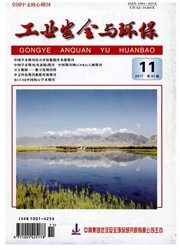

 中文摘要:
中文摘要:
以延安市安塞县境内杏子河中游主河道水体沉积物为研究对象,研究石油类污染物对上覆水体的二次污染规律。研究表明,在实验条件下,沉积物中石油污染物达到释放平衡的时间为16-18d,上覆水体二次污染的质量浓度分别达到2.8mg/L和3.5mg/L;通过释放前后沉积物的石油含量对比发现,沉积物表层10cm厚度对水体的污染贡献最大,是造成水体二次污染的主要源头。根据沉积物组分分析,杏子河沉积物中共检测出11种烷烃,7种多环芳烃。通过释放前后峰面积比较发现,碳原子数在12和17之间的烷烃容易进入水体,成为杏子河石油污染物的主要组成部分。另外,杏子河多环芳烃污染的主要组份是苊、芴、异丙基萘、菲、蒽、苯并[a]芘。
 英文摘要:
英文摘要:
The sediments collected from Xinzi River at Ansai County in Yan' an city is study for the regularity of oil poilu- tants secondary pollution. The result shows the equilibrium time that oil pollutants released from the sediments to water is 16 - 18 days and the oil secondary pollution intensity of overlying water can reach 2.8 mg/L and 3.5 mg/L respectively. The comparisons of oil contents in sediments before and after the release find that the 10cm deposit thickness from surface sedi- ment largely contributes to secondary pollution and it is the main pollution source; the results of petroleum components analy- sis in sediments show that there are 11 kinds of alkanes and 7 kinds of PAHs in the sediments of Xinzi River. The alkanes whine carbon number is between 12 and 7 is easily entered into the water body and has been the main component of petroleum pollutants in water body. At the same time, components of PAHs pollutants include acenaphthene, fluorine, iso- propylnaphthalene, phenanthrene, anthracene and benzo(a) pyrene.
 同期刊论文项目
同期刊论文项目
 同项目期刊论文
同项目期刊论文
 期刊信息
期刊信息
